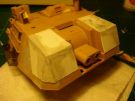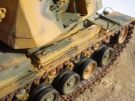Ref : Tamiya #35126 M247 Sergeant York
Eduard #35757
Bronco #BRN3529 M48 /M60 tracks


Conversion, texts and photos by Joseph BERTUCCI
A picture seen on the Internet raised my interest and my curiosity and led me to do my research on this vehicle on a historical point of view as well as on the building one. This most expensive project in the history of US armor proved to be also the greatest technological failure.
Information is
still lacking concerning the changes made to the first model built after the
Vietnam war that resulted in the second generation model. Some questions remain
unanswered.
The Tamiya kit which is still good had been upgraded with some Eduard PE, Bronco
tracks and a good amount of scratchbuilding.
I modeled a vehicle during trials in the field.
Historical
background:
In 1981 the M247 Sergeant York
entered service with the US Army air-defense.
First 12 production vehicles were ordered the same year. A total of 618 units were planned, however only about 50 vehicles were built. Funding of the program was cancelled in 1985 due to unsatisfactory performance and a number of technical problems. The main reasons were insufficient range of fire against air targets, low traveling speed and a number of troubles with the tracking radar. The M247 Sergeant York was withdrawn from service short after.
The M247 is fitted with fully-stabilized
twin 40-mm Bofors anti-aircraft guns. The Sergeant York is fitted
with the Westinghouse AN/APG-68 search and track radar. It is a modified version of the
F-16 fighter aircraft fire control radar. The Sergeant York is also fitted
with a laser rangefinder and digital fire control system.
The vehicle has a crew of three,
including commander, gunner and driver.
The M247 Sergeant York is based on the M48A5 Patton medium tank chassis. It is powered by the Continental AVDS-1790-2D diesel engine, developing 750 horsepower. It is worth mentioning that the M247 had a maximum road speed on only 48 km/h and it could not keep pace with the M1 Abrams and M2 Bradley vehicles, it was designed to protect.
A 10-cylinder engine developing an unknown power has certainly been introduced from the second batch which explains the larger, longer and more angular engine deck.
The
kit:
This 30 year old kit, also reboxed or copied by Academy, has still its
qualities, of which the easy build, despite some inaccuracies in its design like
the rear baskets, the turret, the vision blocks and the turret sides. Tamiya
matched a turret over a
M48A3 hull as basically a M48A5 is a A3 with a 105mm gun and a new engine and
transmission block.
A/The turret
It is too simplified and requires a number of modifications to correspond to the real vehicle. Tamiya designed 5 vision blocks whereas for real only 4 exist. A modification consists in removing one vision block without altering the general lay-out on the roof.
Then, Tamiya ammo bins and cannons access panels are set back of the turret sides; when looking at the real vehicle, we can notice the bins are protruding due to the thickness of the covers.
The covers are modified with some plastic card. The hinges on the sides are added as well as the locking device at the front. The ammo bins are missing in the kit, they are made with PE parts. The protection plate of the folded down radar is also used for the stowage of the crew gear. The bottom grille is added from scratch.
The antennas are new acupuncturist needles, they are very fine and really resistant. I chose them because they are a very good representation of antennas.
Some accessories like the crew gear and the folding cots are home made in resin. Others come from the spare parts box. On the smoke-grenade dischargers brackets as well as on other locations, the resin bolt heads are home made.
B/The hull
The bulk of
the work which is needed concerns the rear of the chassis that is the engine
compartment. This extended compartment required a long-term job as no data is
available. The modification was done from pictures. When comparing the both
chassis, one can notice that the engine was changed or modified.
The towing cables were made from twisted computer wiring. The lights were
hollowed, painted and filled with clear resin. The PE parts give the final touch
in terms of fineness.
C/The tracks
The kit vinyl ones are replaced by the Bronco set. This was my first experience with individual links assembly, I was flabbergasted by the amount of parts that assemble together to get a very realistic and workable set.The link-by-link assembly is time-consuming and boring but you must be patient and take your time. In the end, Bronco quality comes as a reward.
D/Painting and decoration
The whole vehicle gets a coat of professional primer. Then a coat of Humbrol 93 sand is sprayed over the vehicle. The camouflage is done with some Humbrol 101 green. Regarding the decoration, it is very succinct.
E/Diorama
Temporarily set on two different bases, the Sergeant York will finally be displayed in a scene depicting a place somewhere ... in the US desert.
References :
Prime portal
Military today.com
Kr.blog

|

|

|

|

|

|

|

|

|

|

|

|

|

|

|